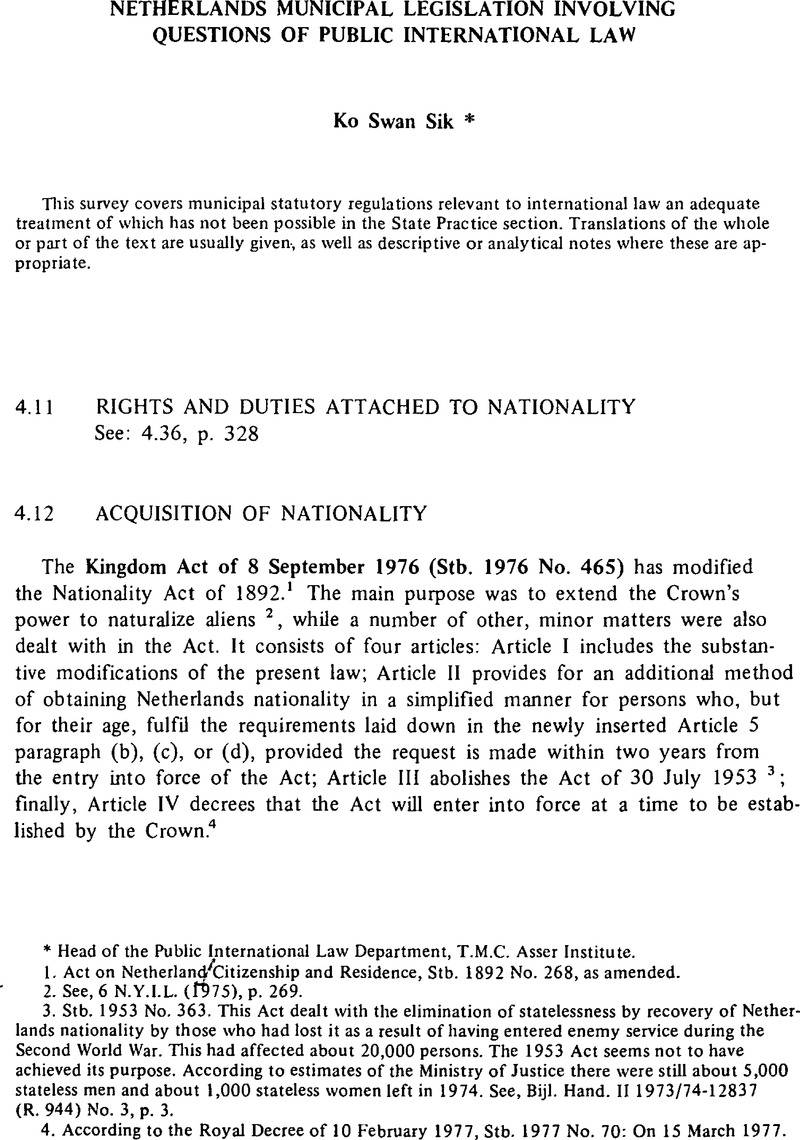No CrossRef data available.
Article contents
Netherlands municipal legislation involving questions of public international law
Published online by Cambridge University Press: 07 July 2009
Abstract

- Type
- Documentation
- Information
- Copyright
- Copyright © T.M.C. Asser Press 1977
References
1. Act on Netherland Citizenship and Residence, Stb. 1892 No. 268, as amended.
2. See, 6 N.Y.I.L. (1975), p. 269.
3. Stb. 1953 No. 363. This Act dealt with the elimination of statelessness by recovery of Netherlands nationality by those who had lost it as a result of having entered enemy service during the Second World War. This had affected about 20,000 persons. The 1953 Act seems not to have achieved its purpose. According to estimates of the Ministry of Justice there were still about 5,000 stateless men and about 1,000 stateless women left in 1974. See, Bijl. Hand. II 1973/74–12837 (R. 944) No. 3, p. 3.
4. According to the Royal Decree of 10 February 1977, Stb. 1977 No. 70: On 15 March 1977.
5. Royal Decree cited in n. 4. From a systematic point of view the reference to regulation by the Crown should also have been moved to a separate article, for the same reason as the removal of the provision on prevention of multiple nationality. The reason for this inconsistency seems to be that, according to the original bill, naturalization fees would only have applied for naturalization by formal Act, while naturalization by the Crown under the new Article 5 would have been free of charge. In the course of the parliamentary discussion, however, the bill was amended. See, Bijl. Hand. II 1973/74–12837 (R. 944) No. 2; Bijl. Hand. II 1974/75–12837 (R. 944) No. 6, p. 3; id. No. 7, p. 11.
6. See, the explanatory memorandum to the bill, Bijl. Hand. II 1973/74–12837 (R. 944) No. 3, p. 3.
7. The age of twenty-five was chosen in order to prevent aliens from postponing their application until such time as the chances of their being drafted for compulsory military service had virtually disappeared. See, id., p. 4.
8. In the Government's view the removal of statelessness in this case makes it acceptable to allow a minor to apply for naturalization. The provision is to be regarded as the implementation of Art. 32 of the Convention relating to the Status of Stateless Persons, of 28 September 1954.
9. See, 7 N.Y.I.L. (1976), p. 249–250.
10. Trb. 1975 No. 135.
11. “Netherlands nationality will be lost: … (4) by entry into foreign military or State service without Our permission; …”
12. As to the purposes of the Act, and the problem of South Moluccans in general, see, 6 N.Y.I.L (1975), pp. 272–274, and 7 N.Y.I.L. (1976), pp. 251–253.
13. Article 3 of the Compulsory Military Service Act (Dienstplichtwet) 1922, as amended, deals with voluntary military service. Paragraph 4 provides that if the duties flowing from a volunteer contract are largely the same as those of a conscript, the person concerned will be treated as a conscript so far as the application of the law is concerned.
14. Algemene Arbeidsongeschiktheidswet, Act of 11 December 1975 on a general (system of) disablement insurance, Stb. 1975 No. 674.
15. Art. 91 provides that only Netherlands citizens are entitled to receive disablement benefits.
16. The Act of 23 September 1965, Stb. 1965 No. 428.
17. Stb. 1975 No. 352, see, 7 N.Y.I.L. (1976), p. 372.
18. By Art. 23 of the 1962 Act the following regulations were repealed; (1) the Act of 3 August 1914 (Stb. 1914 No. 344); (2) the “Crisis Export Act” (Stb. 1931 No. 553); (3) the Retorsion Act (Stb. 1933 No. 417); (4) the Emergency Import Act 1939 (Stb. 1939 No. 639R); (5) the Import and Export Regulation Decree 1944 (Stb. 1944 No. E 80).
The following two Acts which were introduced in connection with League of Nations sanctions, however, are still in existence: the Export Prohibitions Act 1935 (Stb. 1935 No. 599, as amended in Stb. 1958 No. 296), and the Sanctions Act 1935 (Stb. 1935 No. 621, as amended in Stb. 1958 No. 296). Cf., supra, p. 205 on the introduction of a new Sanctions Bill.
19. According to Art. 1(3) of the 1962 Act this term includes decisions of international organizations.
20. Under this enabling provision the following Decrees have been promulgated: (1) the Import and Export Decree for agricultural goods 1963 (Stb. 1963 No. 125), (2) the Import and Export Decree for industrial goods 1963 (Stb. 1963 No. 126), (3) the Decree on the import of goods originating from certain countries and territories or of unknown origin (Countries Import Decree 1963, Stb. 1963 No. 127), (4) the Export Decree for Strategic Goods 1963 (Stb. 1963 No. 128), (5) the Southern Rhodesia Import and Export Decree 1966 (Stb. 1966 No. 289), (6) the Coffee Import and Export Decree 1969 (Stb. 1969 No. 321, repealed in 1974, Stb. 1974 No. 109), (7) the Amphetamines Import and Export Decree (Stb. 1972 No. 572), and (8) the Cocoa Import and Export Decree 1973 (Stb. 1974 No. 107).
It is to be noted that the Royal Decree of 7 November 1968 on the import and export of goods from and to Southern Rhodesia (Stb. 1968 No. 620) was based on the 1935 Acts, mentioned in n. 18 above.
21. Particularly, but not exclusively, flowing from the legal order of the European Communities. Cf., supra, p. 205 on the introduction of a new Sanctions Bill.
22. Trb. 1968 No. 142, 1969 No. 106, 1977 No. 15. The Convention entered into force on 17 December 1969 for Cyprus, Malta and the United Kingdom. The Netherlands ratified the Convention on 1 December 1976.




